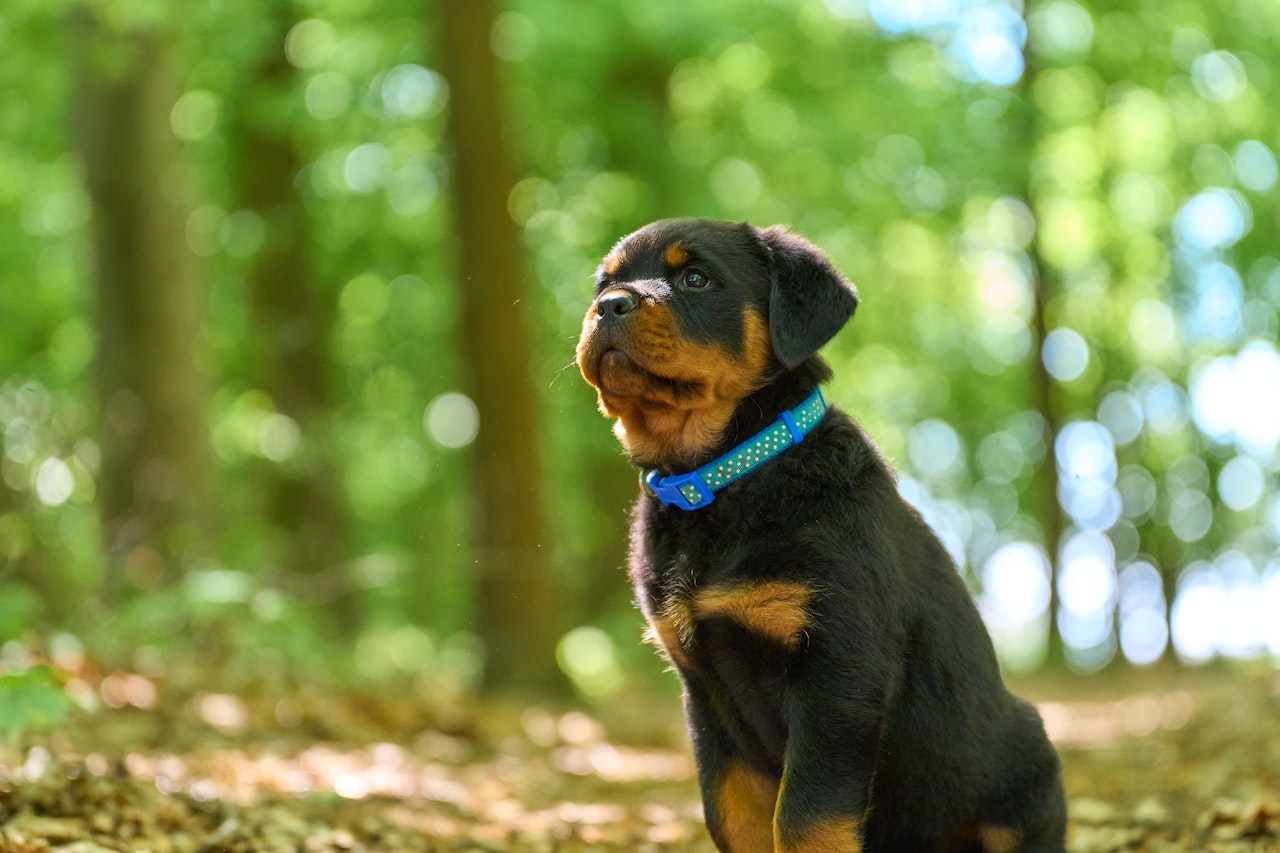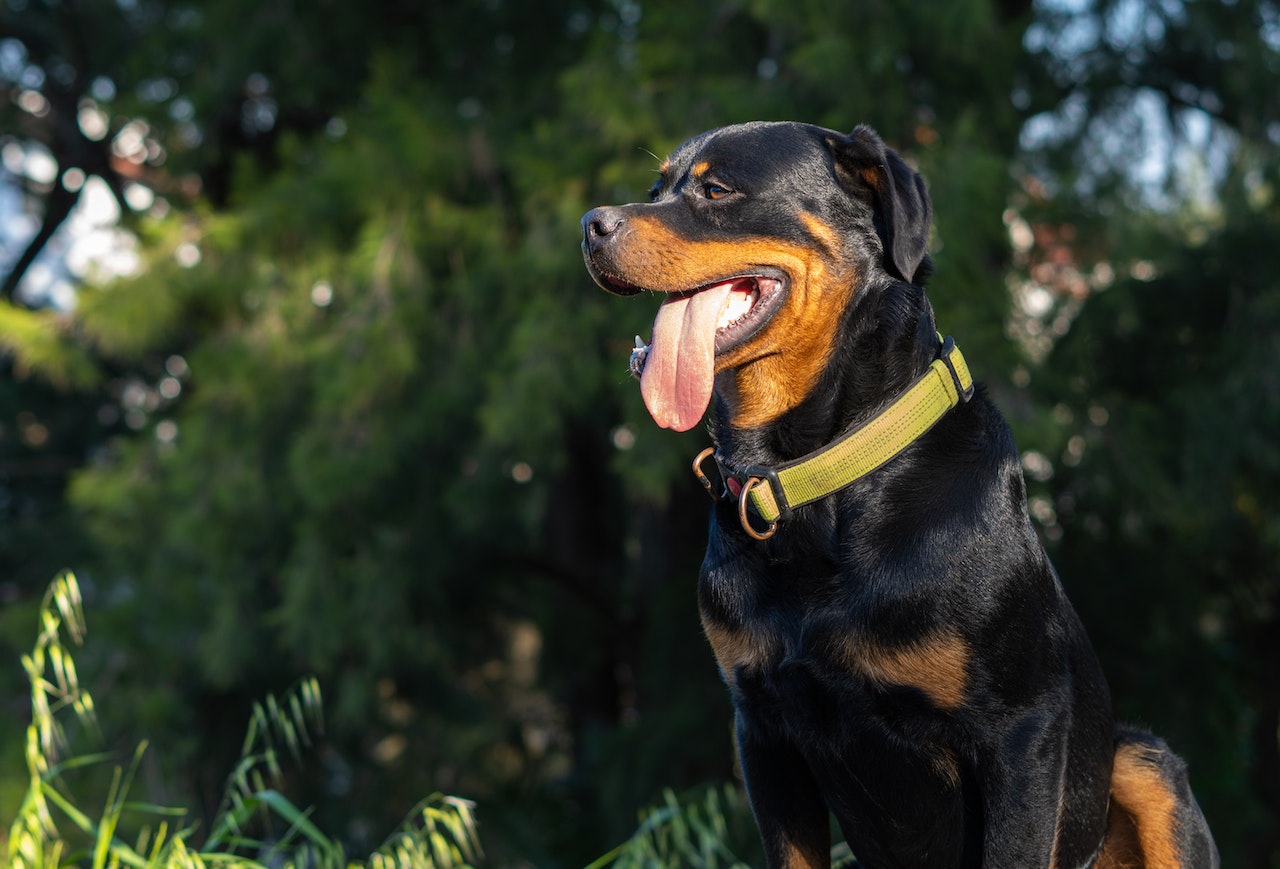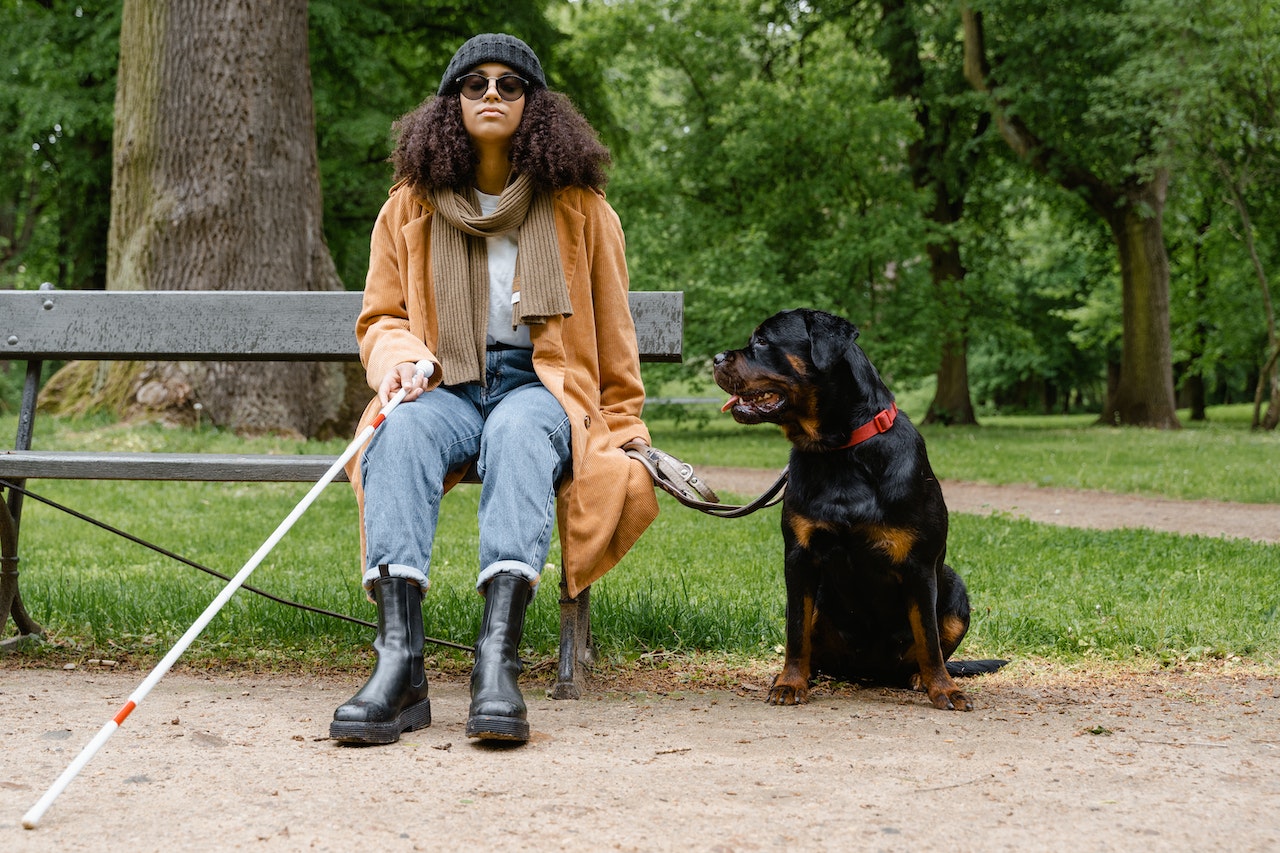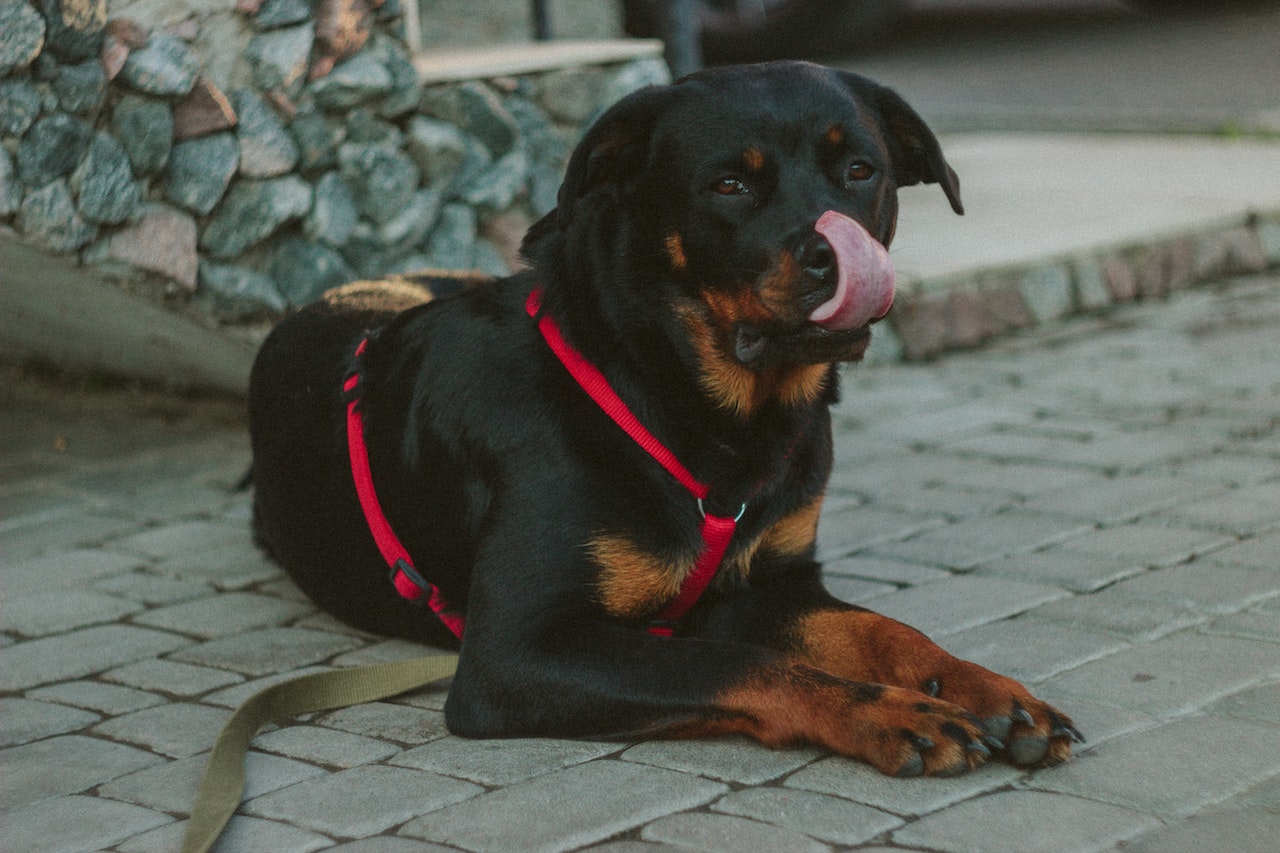Are you curious about what does a Rottweiler dog look like? Like any other dog with a long and rich history of being a working companion, Rottweilers love to be busy. These are not dogs who will like being left behind all day. Very importantly, they are liked by their family, guardians, and friends. These breeds are robust and energetic; as a result, new pet owners should exercise caution. They need expert care and training.
Pet owners that are consistent and enthusiastic will discover a loving, devoted, and clever companion for life in a Rottweiler. Now let’s continue to learn more about Rottweiler dogs.
History of Rottweiler Dog
The Rottweiler is one of the oldest known dog breeds, based on the FCI Standard. Its origins may be traced to the Roman era. These canines were used as herders or as driving dogs. They marched alongside the Roman troops across the Alps, guarding the people and driving their livestock. In the Rottweiler area, these canines met and interacted with the indigenous dogs in a natural crossover. The major role of Rottweilers was to drive and protect cow herds, as well as to defend their owners and their property.
This breed was known as the “Rottweiler butcher dog” in the former free city of Rottweiler. Butchers bred this sort of dog only for performance and utility. Over time, a first-rate watch & driving dog that could also be utilized as a field dog emerged.
During the prelude to World War I, there was a high demand for guard dogs, which sparked renewed interest in the Rottweiler. Throughout the First and Second World Wars, Rottweilers served as messengers, ambulances, draught dogs, and security dogs.
In 1921, several South German Rottweiler Club merged to establish the Allgemeiner Deutscher Rottweiler Klub (ADRK, General German Rottweiler Breed Clubs). On January 27, 1924, this was formally listed in the registry of clubs and organizations at the district court of Stuttgart. The ADRK is known across the globe as the German Rottweiler Club.
The American Kennel Club officially recognized the Rottweiler in 1931. Rottweilers were first shown in Britain in Crufts in 1936. A separate registration for the breed was established in 1966. The Rottweiler’s popularity peaked in the mid-1990s when it was the most registered dog with the American Kennel Club. The Rottweiler was named the ninth most popular breed dog in the United States by the American Kennel Club in 2017.
The Rottweiler Breed Characteristics

Rottweilers are among the most famous dog breeds in the United States, and for a good reason. This large dog breeds like working; their name is taken from the German word Rottweiler Metzgerhund. Throughout history, they have served in various essential roles with other dogs, including police dogs, guide dogs, & search-and-rescue dogs.
However, this giant dog breed is more than just a hard worker. The Rottweiler may be a sweet friend that emanates devotion and affection for his family with reinforcement training and socialization. Here are some facts about Rottweiler dogs.
🐕Appearance
Rottweiler pups are adorable and energetic when they are young. These powerful dog breeds have enormous heads, broad bodies, and hefty bones, standing 22-27 inches at the shoulder & weighing 80-135 pounds. His medium-length coat is black and lustrous, with rust patterns on his face, chest, & legs.
Rottweiler babies have long, curled tails, while adults typically have nothing but nubs on their behind. However, tail docking is a contentious technique. Proponents suggest that docking a dog’s tail saves them from being hurt at work; however, the American Veterinary Medical Association claims this lacks sufficient scientific basis. The surgery is often performed mainly for aesthetic reasons. Docking may be uncomfortable for your dog breed as well.
🐕Temperament
Rottweilers have enormous brains to match their big heads, yet their high intellect means they like being busy with duties and are excellent learning companions. Those who bring a Rottweiler puppy home should be skilled dog owners dedicated to giving daily learning opportunities & mental enrichment to keep their dog healthy and happy. Rottweilers, like other dog breeds, react well to constant positive training.
Like any dog with a long history of being a working companion, they want to stay busy, “says Haylee Bergland, Daily Paws’ editor of Pet Behavior and Health. “These are not dogs who will like being left alone all day. They want to go out and discover the world with you, but since they may grow to be large, hefty dogs, invest in a proper-fitting collar and leash and devote enough time to loose-leash walks from puppyhood through maturity and beyond.
🐕Personality
Rottweilers were chosen for guarding and protective tasks, which must always be remembered. Rottweilers that have been well-socialized got along well with humans and other dogs, although males, in particular, may be aggressive and dominating. They are active, clever dogs that are self-assured enough to behave on their own. So they need supervision from the start.
If left to their own ways, Rottweilers may become an annoyance to barkers, even diggers, and their size makes them capable of causing significant damage. Rottweilers were bred to work and thrive with training and tasks, even if just as a children’s friend. Aggression may be an issue, and this dog can do terrible harm; thus, Rottweilers need a strong, gentle hand and an informed owner.
🐕Training and Obedience
Rottweilers, like any clever dog, are incredibly obedient and simple to teach. Many Rottweilers may pick up new instructions and tricks in as few as five repetitions. Some Rottweilers could learn in only one class. Rottweilers are very adept at the tasks they were bred for. In other words, most Rottweilers are strongly inclined to be to be working dogs and dodo numerous activities.
🐕Intelligence
The adaptable intelligence of the Rottweiler is perhaps the most outstanding part of its intellect. A dog’s capacity to learn from other individuals or from its own history is referred to as adaptive intelligence. Because most dogs have relatively poor adaptive intelligence, they must be educated.
Rottweilers are so clever that they can readily pick up on orders or circumstances by watching you or other dogs. Similarly, they may problem-solve & learn from their own experiences to overcome challenging situations. Rottweilers are distinguished because of their adaptable intelligence.
How to Take Care The Rottweiler Dog

Rottweilers are bright and energetic dogs that need a variety of activities to keep their bodies and minds occupied. Training requires consistency. They are quite powerful and should not be left unsecured with minors. If you’re considering getting this breed, make sure you have lots of time to devote. They should be good with teens if properly monitored and socialized, but they may not be suited for households with small children.
Here are some ways to take care of the Rottweiler dog.
✔️Spaying and Neutering
Spaying & neutering are treatments that assist in reducing various health and behavioral difficulties and unplanned pregnancies. A Rottweiler puppy ought to have this done around the age of six months. Discuss this technique with your vet during Rottweiler puppy visits or the first appointment after adopting an older dog.
Neutering guys may help avoid testicular cancer, prostate issues, urine marking, and other aggressive tendencies. Females Rottweiler puppy spayed before their second season had a far lower chance of mammary tumors and no risk of uterine infections or cancer.
✔️Feeding
The nutrition of your Rottweiler will differ based on its age. You’ll need to give them a portion of comprehensive commercial dog food to keep them thin and healthy.
Your veterinarian will be able to advise you on how much food your dog should be consuming. It is commonly advised to divide their daily allotment into two meals. If you reward your dog occasionally or use rewards for training, consider accounting for this and cutting their daily food intake. Treats should not account for more than 10 percent of their daily calorie intake since this might throw their diet off balance.
✔️Grooming
Rottweilers have short, silky hair that has to be brushed less often than other breeds, perhaps twice a week. A rubber hound mitt and soft bristle brush is the ideal sort of brush to apply to your dog. The coat is generally simple to keep, although the breed sheds much more than you may expect.
Your Rottweiler’s short hair also means fewer baths. Bathe your dog as needed, such as if he chooses to roll around outdoors. Use an ear cleanser to flush out the dog’s ears at wash time.
✔️Exercise
Rottweilers are huge dogs that need a lot of activity. You must take your dog for at least two ten-to-twenty-minute walks every day. Without exercise, your dog may get bored and possibly destructive. This might manifest as scratched furniture in your house or large holes excavated in your yard.
Rottweiler Health Problems
Rottweilers are typically healthy; however, they are susceptible to some health issues, as are all breeds. Not all Rottweilers will get one or all of these illnesses, but it’s vital to be aware of them when you’re thinking about getting one. Here are some health problems of Rottweiler.
🔬Hip Dysplasia
The thighbone does not fit securely into the hip joint in this heritable disease. Some dogs exhibit pain and stiffness on one or both back legs, but a dog with hip dysplasia may show no indications of discomfort. Arthritis might occur as the dog matures. The Orthopedic Foundation for Animals and the University of Pennsylvania Hips Improvement Program provide X-ray screening for hip dysplasia.
Hip dysplasia is inherited, but it may be exacerbated by external factors such as fast development as a result of a high-calorie diet and injuries sustained when leaping or falling on slippery floors.
🔬Elbow Dysplasia
Elbow dysplasia is a genetic elbow joint deformity. X-rays are the only way to identify the degree of dysplasia. Your veterinarian may advise surgery to repair the condition or pain medication to alleviate the discomfort.
🔬Aortic Stenosis
Rottweilers are prone to this prevalent cardiac defect. The aorta narrows underneath the aortic valve, requiring the heart to work more to deliver blood to the body. This syndrome might result in fainting and even death. It is a hereditary disorder, although the route of transmission is unknown at this moment. A veterinary cardiologist often identifies this illness after detecting a cardiac murmur.
🔬Osteosarcoma
Osteosarcoma is a severe bone cancer that mostly affects big and gigantic breeds. The initial indication of osteosarcoma was lameness, but x-rays will be required to confirm if the reason is malignancy. Osteosarcoma is aggressively treated, generally with amputation and chemotherapy.
Dogs may survive for nine months up to two years or over with therapy. Fortunately, dogs adapt well to life with three legs and do not have the same chemotherapy side effects as people, such as nausea & hair loss.
🔬Allergies
Allergies are a very prevalent problem in dogs. Food allergies are recognized and treated by removing certain items from the dog’s health until the cause is found. Contact allergies result from a response to anything that comes into contact with the dog, like bedding, flea powder, dog shampoos, or even other chemicals.
🔬Panosteitis
This is known as “growing pains” since it normally appears in pups around four months. The most obvious sign is lameness. Rest is often all that is required, but if your puppy begins limping, see your veterinarian.
Living With Rottweiler Dog

Rottweilers are quite simple to care for such huge canines and, in fact, have a predisposition to obesity if not well exercised. Coat maintenance is modest; most of the time, short weekly grooming will be sufficient. Some Rottweilers drool, particularly huge males with loosened flies (lips).
One of the essential things to know about Rottweilers is that they require substantial and ongoing socialization in order to be ideal family pets. Training is essential and should begin as soon as the puppy is born. Their bravery is undeniable, but it may be misguided. This breed is not recommended for first-dog owners. Rottweilers like working and will gladly participate in almost every canine sport, from obedience through herding and weight pulling.
From the outset, a rottweiler should be introduced to other pets, especially dogs and children. Rottweilers are frequently too protective of their children and must be kept under close supervision while around youngsters. This breed should only be obtained from a dog breeder since its popularity has resulted in certain temperaments and health issues. Rottweilers have a lifespan of roughly 12 years.
Frequently Asked Questions
Is a Rottweiler suitable as a family dog?
Are Rottweilers suitable as family dogs? Rottweilers are people dogs that are loving and devoted to their owners. They are wonderful family companions and also make good protection dogs for households. They typically follow their favorite person from place to place, ensuring that they are constantly in their line of sight.
Are Rottweilers aggressive?
According to a 2008 research, although Rottweilers were not exceptionally hostile toward their owner, other dogs, or people they knew, they were particularly aggressive against strangers. Many Rottweiler owners note that, although the dogs do not pose a danger to their families, they may be exceedingly protective of their owners.
Is your Rottweiler a barker?
Rottweilers are calm, quiet canines that don’t bark much. Rottweilers are not a very vocal breed; many owners report that they seldom hear their Rottweiler bark. They bark when necessary but otherwise react calmly to their surroundings.
Do Rottweilers like cuddling?
Rottweilers are lively and loving with their families. This enormous dog, regardless of size, enjoys cuddling on the sofa or bed.
What two dog breeds combine to get a Rottweiler?
Rottweilers are believed to be derived from the Molossus, a mastiff-type dog, and maybe from the Italian Mastiff. Their forefathers followed the Romans through the Alps by herding and guarding their animals.
Final Thoughts
Now that you know what a Rottweiler dog looks like, it’s time to choose your next best companion breed. When you encounter a Rottweiler, you’ll know you’re looking at a dog with a centuries-long history. You can better comprehend Rottweilers now that you know how they were bred and what their ancestors faced. Because of their extensive history, Rottweilers are gentle giants with extraordinarily high IQs.
Whether you want a sympathetic companion dog or a working dog that can solve difficult challenges, the Rottweiler may be the right option for you. Do you want to know what is the rarest chihuahua? Click Here!

